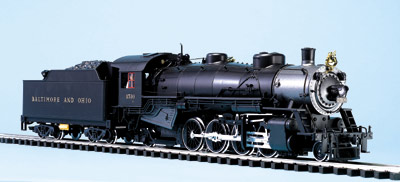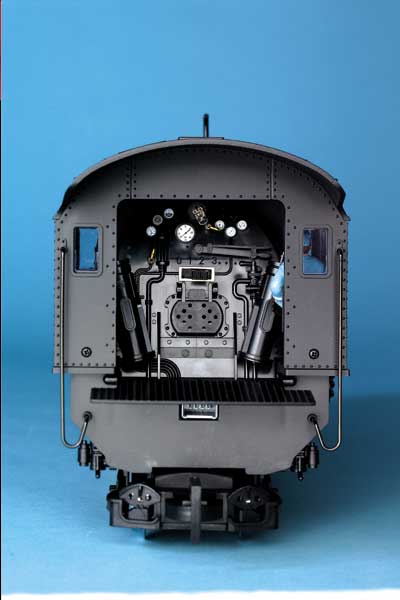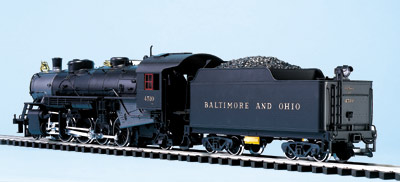LGB is best-known for its G scale narrow gauge line, but the firm also offers some standard gauge prototype equipment which operates on the same No. 1 gauge track that its narrow gauge line uses. However, while the narrow gauge line is 1:22.5 scale (correct for meter-gauge prototypes on No. 1 gauge track), the firm’s standard gauge pieces follow the industry trend in being scaled larger (approximately 1:26) rather than the 1:32 scale that is accurate for standard gauge prototypes on No. 1 gauge track.
The prototype for LGB’s Mikado is the United States Railroad Administration light 2-8-2 – an excellent choice. The USRA light 2-8-2 was the most popular of the government-standard locomotives built during World War I. The 625 original light “Mikes” assigned to 31 railroads made up a third of the USRA’s total locomotive construction. An additional 1,266 copies were built after USRA control ended in 1920. Baltimore & Ohio no. 4500 was the very first USRA locomotive delivered, in 1918. It was followed by 99 sisters of B&O class Q-3, engines 4501-4599. Ninety-seven remained in service until 1956, but all were retired by 1959. The model is well proportioned and for the most part it captures the as-delivered appearance of the real thing. However, two features that detract from the model’s realism are the trailing and tender trucks. To be correct, the trailing truck should be the bolted-together Hodges type instead of the cast-frame Delta truck used on the model. On the real engine, the trailing truck supported the firebox, but the model’s trailing axle is too far back under the cab. The tender should have Andrews solid-bearing trucks with elliptical (leaf) springs. Instead it rides on a pair of roller-bearing freight trucks with cast sideframes and coil springs from much later in the twentieth century.
Some mechanical surprises LGB has long held to a standard of building all its equipment to operate on the firm’s smallest-radius (approximately 645mm, or 25.4″) curved track. Making a locomotive with a long rigid wheelbase, like this 2-8-2, negotiate such sharp curves is a problem. Rather than using “blind” (flangeless) inner drivers that would ride inside the rails on sharp curves, LGB chose to articulate the frame. The rear section includes the ashpan, while the front section has the cylinders and pilot with a flexible joint between them.
A powerful motor is concealed in the ashpan. (Creating space for the motor is probably why the trailing truck was moved to the rear.) A driveshaft, with couplings beefed up from those of an earlier version of this Mikado, carries power forward to the twin gearboxes.
Within each gearbox, one axle is driven by a worm and worm gear, while the other is powered by the side rods. The rod-powered axles, which are in the center of the locomotive, are sprung. To allow the frame to articulate, the driveshaft has a center universal, the main rods are jointed at the crankpins, and the crankpins slide within the side rods. The articulated frame is a clever and effective solution to LGB’s dilemma, but the sight of the frame flexing through curves seems a bit odd the first few times you see it. The bend is barely noticeable on LGB R3 (48.95″-radius) curves. While the locomotive can go around R1 curves, it does so only with difficulty, and you’ll need to bend the air compressor away from the rods to provide enough clearance when turning to the right on R1 curves.
With eight drivers picking up power, plus four sliding pickup shoes, the locomotive has no trouble maintaining contact over turnouts, though we did see some sparks at the frogs when operating at less than ten scale mph.
Control and sound The standard-equipment decoder worked well in both analog and DCC modes, and the locomotive operates very smoothly. Because of the onboard electronics, the locomotive does not respond until track voltage is 7 volts or more, but its current draw is remarkably low given its size.
The big Mike’s maximum speed on LGB’s DCC Multi-Train system is precisely 60 scale mph – excellent! (And, if you need to remove any wallpaper or move some furniture, its pulling power is slightly more than four pounds or about 64 free-rolling cars!) The decoder is load-regulated, so the locomotive maintains a steady speed through curves and up and down grades while running on DCC.
The sound system is reliable and realistic, especially since the speaker is in the boiler so the sounds emanate from the locomotive instead of the tender. The exhaust sounds were produced at the correct rate of four chuffs per driver revolution, and the sound quality was remarkable – and very similar to that of restored Soo Line Mikado no. 1003. Operating in digital mode gives full control over the sound functions, but the locomotive also whistles at startup (and over track-mounted magnets) in the analog mode.
Overall, LGB’s newest Mikado is a fine model of a well-known and widely used prototype, and having factory DCC and sound only enhances its appeal. The engineers in Nuremburg have created another winner – a big winner.
Price: $1,849.99
Manufacturer:
LGB of America
6444 Nancy Ridge Road
San Diego, CA 92121
Phone: 858-535-9387
Description:
Ready-to-run plastic and metal steam locomotive
Road Names:
Baltimore & Ohio or Southern Ry.
Features:
Articulated drive
Buhler seven-pole motor
Cab interior with a working firebox door, simulated firebox fire, and movable roof vents
Directional headlights
Drawbar pull: 4.06 pounds with traction tires on rear driver set
Dual-mode decoder for LGB Multi-Train System (MTS Digital Command Control) or DC operation
Engine weight: 16.3 pounds
Four-position control switch in cab
Length of engine and tender: 36.6″ LGB couplers
Minimum radius: 645mm, or 25.4″
Smoke generator in stack
12-point power pickup using eight drivers and four track-slider shoes
Weather-resistant construction

















Nice. wonder if they have it in union paific